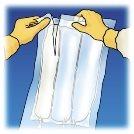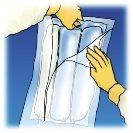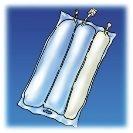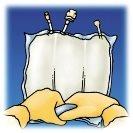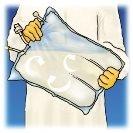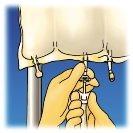
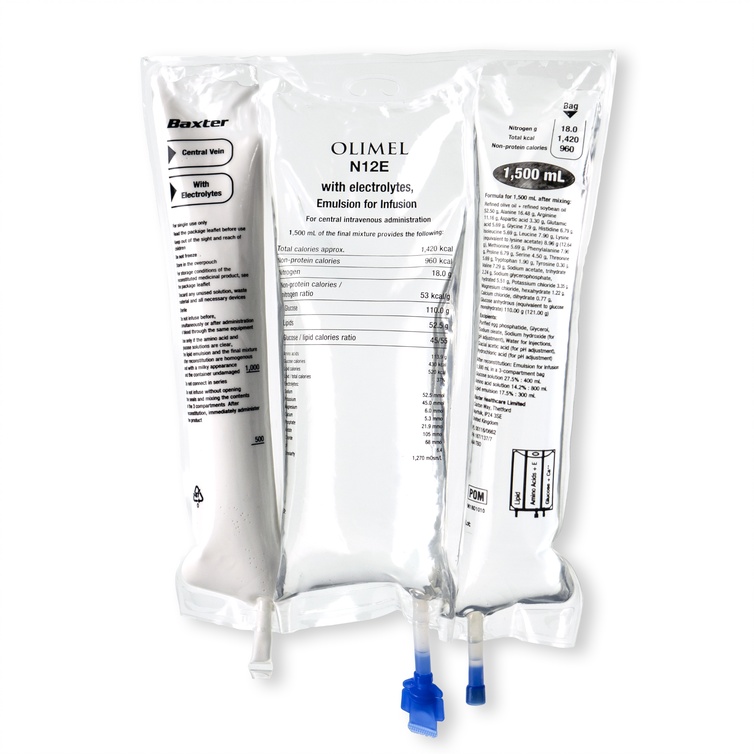
ОЛІМЕЛ N12 ЕМУЛЬСІЯ ДЛЯ ПЕРФУЗІЇ

Запитайте лікаря про рецепт на ОЛІМЕЛ N12 ЕМУЛЬСІЯ ДЛЯ ПЕРФУЗІЇ

Інструкція із застосування ОЛІМЕЛ N12 ЕМУЛЬСІЯ ДЛЯ ПЕРФУЗІЇ
Введення
Опис: інформація для користувача
Olimel N12 емульсія для перфузії
Прочитайте уважно весь опис перед тим, як вам буде введено це лікарське засоби, оскільки він містить важливу інформацію для вас.
- Збережіть цей опис, оскільки вам може знадобитися знову його прочитати.
- Якщо у вас виникли питання, проконсультуйтеся з вашим лікарем або медсестрою.
- Якщо ви відчуваєте побічні ефекти, проконсультуйтеся з вашим лікарем або медсестрою, навіть якщо це побічні ефекти, які не вказані в цьому описі. Див. розділ 4.
Зміст опису
- Що таке Olimel N12 і для чого він використовується
- Що вам потрібно знати перед тим, як вам буде введено Olimel N12
- Як вам буде введено Olimel N12
- Можливі побічні ефекти
- Збереження Olimel N12
- Зміст упаковки та додаткова інформація
1. Що таке Olimel N12 і для чого він використовується
Olimel N12 - це емульсія для перфузії. Він представлений у вигляді мішка з 3 відділами.
Один відділ містить розчин глюкози, другий - емульсію ліпідів, а третій - розчин амінокислот.
Olimel N12 використовується для харчування дорослих та дітей старше двох років через трубку в вену, коли звичайне харчування через рот неможливе.
Olimel N12 повинен використовуватися лише під медичним наглядом.
2. Що вам потрібно знати перед тим, як вам буде введено Olimel N12
Olimel N12 не повинен вводитися:
- У недоношених новонароджених, немовлят та дітей молодше двох років.
- Якщо ви алергічні на білки яєць, сої, арахісу, кукурудзи/кукурудзяних продуктів (див. також розділ "Попередження та обережність" нижче) або на будь-який інший компонент цього лікарського засобу (перелічені в розділі 6).
- Якщо ваш організм має проблеми з використанням певних амінокислот.
- Якщо у вас особливо високий рівень жиру в крові.
- Якщо у вас гіперглікемія (зbyt високий рівень цукру в крові).
У всіх випадках ваш лікар вирішить, чи повинен вам вводитися цей лікарський засіб, виходячи з таких факторів, як ваш вік, вага та клінічний стан, а також результати всіх проведених тестів.
Попередження та обережність
Проконсультуйтеся з вашим лікарем або медсестрою перед тим, як вам буде введено Olimel N12.
Занадто швидке введення розчинів батьківської харчування може спричинити ушкодження або смерть.
Перфузія повинна бути зупинена негайно, якщо розвиваються будь-які аномальні ознаки або симптоми алергічної реакції (наприклад, потіння, гарячка, озноб, головний біль, висипання на шкірі або труднощі з диханням). Цей лікарський засіб містить соєвий олій та фосфоліпіди яєць. Білки сої та яєць можуть спричиняти гіперчутливість. Було зафіксовано алергічні реакції між білками сої та арахісу.
Olimel N12 містить глюкозу, отриману з кукурудзи, яка може спричиняти гіперчутливість, якщо у вас є алергія на кукурудзу або кукурудзяні продукти (див. розділ "Olimel N12 не повинен вводитися" вище).
Труднощі з диханням також можуть бути ознакою того, що в легенях утворилися дрібні частинки, які блокують кровоносні судини (пульмональні вазкулярні осади). Якщо ви відчуваєте будь-які труднощі з диханням, повідомте про це вашому лікарю або медсестрі. Вони вирішать, які дії потрібно вчинити.
Деякі лікарські засоби та захворювання можуть збільшити ризик розвитку інфекцій або сепсису (бактерії в крові). Існує ризик інфекції або сепсису, особливо коли встановлюється трубка (центральний венозний катетер) у вену. Лікар буде уважно спостерігати за ознаками інфекції. Пацієнти, які потребують батьківської харчування (введення харчових речовин через трубку, введену в вену), можуть бути більш схильні до інфекцій через свій медичний стан. Використання "асептичних технік" (без мікробів) при встановленні та обслуговуванні катетера та при підготовці харчової формули (батьківське харчування) може зменшити ризик інфекції.
Якщо ви сильно недохранені та потребуєте харчування через вену, ваш лікар повинен почати лікування повільно. Крім того, вас буде контролювати, щоб уникнути раптових змін у рівнях рідини, вітамінів, електролітів та мінералів.
Перед початком перфузії повинні бути виправлені метаболічні розлади та водно-сольовий баланс вашого організму. Ваш лікар буде спостерігати за вашим станом під час введення цього лікарського засобу та може змінити дозу або додати інші харчові речовини, такі як вітаміни, електроліти та олігоелементи, якщо це буде вважати за необхідне.
Було зафіксовано випадки порушення функції печінки, включаючи проблеми з виведенням жовчі (холестаз), накопичення жиру (стеатоз печінки), фіброз, який може спричинити недостатність печінки, а також холецистит та холелітіаз у пацієнтів, які отримують батьківське харчування. Гадається, що причиною цих порушень є множинні фактори та може відрізнятися між пацієнтами. Якщо ви відчуваєте симптоми, такі як нудота, блювота, біль у животі, жовтяниця шкіри чи очей, повідомте про це вашому лікарю, щоб можна було визначити можливі причини та заходи щодо лікування та профілактики.
Ваш лікар повинен знати, якщо у вас:
- є серйозні проблеми з нирками. Ви також повинні повідомити лікарю, якщо ви проходите діаліз (штучна нирка) або якщо ви маєте інше лікування для очищення крові
- є серйозні проблеми з печінкою
- є проблеми з згортанням крові
- є порушення функції наднирників (недостатність наднирників). Наднирники мають трикутну форму та розташовані над нирками
- є недостатність серця
- є захворювання легенів
- є надмірна кількість води в організмі (гіпергідратация)
- є недостатня кількість води в організмі (дегідратация)
- є надмірний рівень цукру в крові (цукровий діабет) без лікування
- є інфаркт міокарда або шок через раптову недостатність серця
- є тяжка метаболічна ацидоз (кров надто кисла)
- є загальна інфекція (сепсис)
- є кома
Для перевірки ефективності та безпеки введення лікарського засобу ваш лікар буде проводити лабораторні та клінічні тести під час введення цього лікарського засобу. Якщо ви отримуєте цей лікарський засіб протягом декількох тижнів, ваша кров буде регулярно аналізуватися.
Зниження здатності організму виводити жири, які містить цей лікарський засіб, може призвести до "синдрому надмірної кількості жиру" (див. розділ 4 "Можливі побічні ефекти").
Якщо під час перфузії ви відчуваєте біль, печіння або набухання в місці перфузії або витік перфузії, повідомте про це вашому лікарю або медсестрі. Перфузія повинна бути негайно зупинена.
Якщо ваш рівень цукру в крові надто високий, лікар повинен регулювати швидкість введення Olimel N12 або вводити лікарські засоби для контролю рівня цукру в крові (інсулін).
Olimel N12 можна вводити лише через трубку (катетер) у велику вену на вашому грудї (центральна вена).
Діти та підлітки
Якщо ваш дитина молодше 18 років, буде приділено особливу увагу введенню правильної дози. Також повинні бути вжиті додаткові заходи через підвищену чутливість дітей до ризику інфекції. Додавання вітамінів та олігоелементів завжди необхідно. Повинні використовуватися дитячі формули.
Використання Olimel N12 з іншими лікарськими засобами
Повідомте вашому лікарю, якщо ви приймаєте або використовуєте, приймали або використовували нещодавно або можете приймати чи використовувати будь-які інші лікарські засоби.
Одночасне прийняття інших лікарських засобів зазвичай не є протипоказанням. Якщо ви приймаєте інші лікарські засоби, отримані за рецептом або без нього, ви повинні проконсультуватися з вашим лікарем заздалегідь, щоб він міг перевірити їх сумісність.
Повідомте вашому лікарю, якщо ви приймаєте або отримуєте будь-які з наступних лікарських засобів:
- інсулін
- гепарин
Olimel N12 не повинен вводитися одночасно з кров'ю через одну й ту саму перфузійну лінію.
Через ризик осадження Olimel N12 не повинен вводитися через одну й ту саму перфузійну лінію чи змішуватися з антибіотиком ампіциліном чи протиепілептичним засобом фосфенітоїном.
Оливкова та соєва олія, присутні в Olimel N12, містять вітамін К. Це зазвичай не впливає на лікарські засоби для розрідження крові (антICOагулянти) типу кумарину. Однак, якщо ви приймаєте антICOагулянти, ви повинні повідомити про це вашому лікарю.
Ліпіди, які містить ця емульсія, можуть впливати на результати деяких лабораторних тестів, якщо зразок крові береться до того, як вони будуть виведені з вашого кровотоку (зазвичай виводяться через 5-6 годин без прийняття ліпідів).
Вагітність та лактація
Якщо ви вагітні або перебуваєте у період лактації, вважаєте, що можете бути вагітні або плануєте вагітність, проконсультуйтеся з вашим лікарем перед тим, як вам буде введено цей лікарський засіб.
Немає достатнього досвіду використання Olimel N12 у вагітних жінок або під час лактації. Olimel N12 можна використовувати під час вагітності та лактації, якщо це необхідно. Olimel N12 повинен вводитися вагітним жінкам або жінкам у період лактації лише після ретельного розгляду.
Фертильність
Немає достатніх даних
Водіння транспортних засобів та робота з машинами
Не застосовується.
3. Як вам буде введено Olimel N12
Доза
Olimel N12 повинен вводитися лише дорослим та дітям старше двох років.
Це емульсія для перфузії, тобто для введення через трубку (катетер) у вену на вашому грудї.
Olimel N12 повинен бути при кімнатній температурі перед його використанням.
Olimel N12 призначений для одноразового використання.
Доза - дорослі
Ваш лікар визначить швидкість перфузії залежно від ваших потреб та клінічного стану.
Протокол лікування може тривати так довго, як це необхідно, залежно від вашого клінічного стану.
Доза - діти старше двох років та підлітки
Лікар визначить дозу та тривалість лікування залежно від віку, ваги, зросту, клінічного стану та здатності організму розщеплювати та використовувати інгредієнти Olimel N12.
Якщо вам було введенобільше Olimel N12, ніж потрібно
Якщо введена доза надто висока або перфузія відбувається надто швидко, вміст амінокислот може зробити вашу кров надто кислою, та можуть розвинутися ознаки гіперволемії (збільшення об'єму циркулюючої крові). Рівень глюкози в вашій крові та сечі може збільшитися, може розвинутися гіперосмолярний синдром (надмірна в'язкість крові) та вміст ліпідів може збільшити рівень тригліцеридів у вашій крові. Надто швидке або об'ємне введення Olimel N12 може спричинити нудоту, блювоту, озноб, головний біль, гарячку, потіння, надмірне потіння (гіпергідроз) та порушення електролітного балансу. У цьому випадку перфузія повинна бути негайно зупинена.
У деяких випадках лікар може бути змушений тимчасово провести діаліз нирок, щоб допомогти вашим ниркам вивести надмірний лікарський засіб.
Для уникнення цих випадків ваш лікар буде регулярно контролювати ваш стан та аналізувати ваші показники крові.
Якщо у вас є будь-які питання щодо використання цього лікарського засобу, проконсультуйтеся з вашим лікарем.
У разі передозування або випадкового прийняття лікарського засобу зверніться до Токсикологічної служби. Телефон 915.620.420.
4. Можливі побічні ефекти
Як і всі лікарські засоби, цей лікарський засіб може спричиняти побічні ефекти, хоча не всі люди їх відчувають. Якщо ви відчуваєте, що ваш стан погіршився, негайно повідомте про це вашому лікарю або медсестрі.
Тести, які ваш лікар буде проводити під час лікування цим лікарським засобом, повинні мінімалізувати ризик побічних ефектів.
Якщо розвиваються будь-які аномальні ознаки або симптоми алергічної реакції, такі як потіння, гарячка, озноб, головний біль, висипання на шкірі чи труднощі з диханням, перфузія повинна бути негайно зупинена.
Було описано наступні побічні ефекти при застосуванні Olimel:
Частота - часта: може впливати до 1 особи з 10
- Прискорене серцебиття (тахікардія).
- Зниження апетиту.
- Збільшення рівня жиру в крові (гіпертригліцеридемія).
- Біль у животі.
- Діарея.
- Нудота.
- Підвищений артеріальний тиск (гіпертонія).
Частота - невідома: не може бути оцінена на основі наявних даних
- Алергічні реакції, які включають потіння, гарячку, озноб, головний біль, висипання на шкірі чи труднощі з диханням.
- Витік перфузії в навколишні тканини (екстравазація) може спричинити біль у місці перфузії, подразнення, набухання/едем, червоність (еритема)/гарячка, загибель клітин тканини (некроз шкіри) чи пухирі/везикули, запалення, загустіння чи стискання шкіри.
- Блювота.
Було описано наступні побічні ефекти при застосуванні інших подібних лікарських засобів для батьківського харчування:
Частота - дуже рідка: може впливати до 1 особи з 10 000
- Зниження здатності виводити ліпіди (синдром надмірної кількості жиру) у поєднанні з раптовим погіршенням стану пацієнта. Наступні симптоми синдрому надмірної кількості жиру зазвичай є оборотними, коли перфузія ліпідної емульсії зупиняється:
- Гарячка.
- Зниження рівня червоних кров'яних тілець, яке може зробити шкіру блідою та спричинити слабкість чи труднощі з диханням (анемія).
- Низький рівень лейкоцитів, який може збільшити ризик інфекції (лейкопенія).
- Низький рівень тромбоцитів, який може збільшити ризик синяків та/або кровотечі (тромбоцитопенія).
- Порушення згортання крові, які впливають на здатність крові згортатися
- Підвищений рівень жиру в крові (гіперліпідемія).
- Жирова інфільтрація печінки (гепатомегалія).
- Погіршення функції печінки.
- Маніфестації з боку центральної нервової системи (наприклад, кома).
Частота - невідома: не може бути оцінена на основі наявних даних
- Алергічні реакції.
- Аномальні аналізи крові для функції печінки.
- Порушення виведення жовчі (холестаз).
- Збільшення розміру печінки (гепатомегалія).
- Порушення функції печінки, пов'язані з батьківським харчуванням (див. "Попередження та обережність" у розділі 2).
- Жовтяниця.
- Зниження рівня тромбоцитів (тромбоцитопенія).
- Збільшення рівня нітрогену в крові (азотемія).
- Збільшення рівня ферментів печінки.
- Утворення дрібних частинок, які можуть призвести до блокування кровоносних судин у легенях (пульмональні вазкулярні осади), що може спричинити емболію легенів та труднощі з диханням (труднощі з диханням).
Звітність про побічні ефекти:
Якщо ви відчуваєте будь-які побічні ефекти, проконсультуйтеся з вашим лікарем або медсестрою, навіть якщо це побічні ефекти, які не вказані в цьому описі. Ви також можете повідомити про них безпосередньо через Іспанську систему моніторингу лікарських засобів для людини: https://www.notificaram.es. Надсилаючи повідомлення про побічні ефекти, ви можете допомогти надати більше інформації про безпеку цього лікарського засобу.
5. Збереження Olimel N12
Тримайте цей лікарський засіб поза зоною досяжності дітей.
Не використовуйте цей лікарський засіб після закінчення терміну придатності, вказаного на упаковці та зовнішній упаковці після (ММ/РРРР). Термін придатності - останній день місяця, який вказано.
Не заморожуйте.
Тримайте в зовнішній упаковці.
Лікарські засоби не повинні викидатися у каналізацію чи сміття. Спитайте у вашого фармацевта, як позбутися упаковок та лікарських засобів, які вам не потрібні. Таким чином, ви допоможете захистити навколишнє середовище
6. Зміст упаковки та додаткова інформація
Склад Олімел N12
Активні речовини кожної сумки реконституїрованої емульсії - це розчин L-амінокислот 14,2% (що відповідає 14,2 г/100 мл аланін, аргінін, гліцин, гістидин, ізолейцин, лейцин, лізин (у вигляді лізину ацетату), метіонін, фенілаланін, пролін, серин, треонін, триптофан, тирозин, валін, аспарагінова кислота, глутамінова кислота), емульсія ліпідів 17,5% (що відповідає 17,5 г/100 мл рафінованої оливкової олії та рафінованої соєвої олії) і розчин глюкози 27,5% (що відповідає 27,5 г/100 мл у вигляді глюкози моногідрату).
Інші складові частини:
Відділ ліпідної емульсії | Відділ розчину амінокислот | Відділ розчину глюкози |
Пурифіковані фосфоліпіди яйця, гліцерол, олеат натрію, гідроксид натрію (для регулювання pH), вода для ін'єкційних препаратів | Оцтова кислота (для регулювання pH), вода для ін'єкційних препаратів | Хлоридна кислота (для регулювання pH), вода для ін'єкційних препаратів |
Вигляд Олімел N12 та вміст упаковки
Олімел N12 - це емульсія для перфузії, упакована в сумку з 3 відділами. Один відділ містить ліпідну емульсію, інший - розчин амінокислот, а третій - розчин глюкози. Ці відділи розділені непостійними пробками. Перед введенням вміст відділів повинен бути змішаний шляхом скручування сумки згори донизу до відкриття пробок.
Вигляд до реконституції:
- Розчини амінокислот і глюкози прозорі, безбарвні або легенько жовтуваті.
- Ліпідна емульсія однорідна та має молочний вигляд.
Вигляд після реконституції: однорідна молочна емульсія.
Трикамерна сумка виготовлена з пластику з кількома шарами. Матеріал внутрішнього шару сумки (контакт) призначений для сумісності з компонентами та дозволеними добавками.
Для уникнення контакту з атмосферним киснем сумка упакована в зовнішню сумку, яка діє як бар'єр проти кисню, та містить пакет з абсорбентом кисню.
Розміри упаковки
Сумка об'ємом 650 мл: 1 картонна коробка з 10 сумками
Сумка об'ємом 1000 мл: 1 картонна коробка з 6 сумками
Сумка об'ємом 1500 мл: 1 картонна коробка з 4 сумками
Сумка об'ємом 2000 мл: 1 картонна коробка з 4 сумками
1 сумка об'ємом 650 мл, 1000 мл, 1500 мл та 2000 мл
Можливо, що тільки деякі розміри упаковки будуть випускатися.
Власник дозволу на продаж
Baxter S.L.
Pouet de Camilo 2, 46394 Ribarroja del Turia (Valencia)
Виробник
Baxter S.A., Boulevard René Branquart, 80, 7860 Lessines, Бельгія
Цей лікарський засіб дозволений в країнах-членах Європейського економічного простору під наступними назвами:
Бельгія, Чехія, Франція, Греція, Італія, Люксембург, Нідерланди, Словенія, Іспанія: <ОЛІМЕЛ N12>
Австрія:<Центро ОЛІМЕЛ 7,6 %>
Німеччина:<Олімел 7,6 %>
Данія, Ісландія, Швеція, Норвегія, Фінляндія, Португалія: <ОЛІМЕЛ N12>
Ірландія, Мальта, Велика Британія: <Тріомел 12 г/л азоту 950 ккал/л>
Дата останнього перегляду цієї інструкціїКвітень 2020
Детальна та актуальна інформація про цей лікарський засіб доступна на сайті Агентства лікарських засобів та медичних продуктів Іспанії (AEMPS) http://www.aemps.gob.es/
Ця інформація призначена лише для медичних працівників
- Якість та кількість складу
Олімел N12 випускається у вигляді сумки з 3 відділами.
Кожна сумка містить розчин глюкози, ліпідну емульсію та розчин амінокислот
Вміст у сумці | ||||
650 мл | 1000 мл | 1500 мл | 2000 мл | |
Розчин глюкози 27,5% (що відповідає 27,5 г/100 мл) | 173 мл | 267 мл | 400 мл | 533 мл |
Розчин амінокислот 14,2% (що відповідає 14,2 г/100 мл) | 347 мл | 533 мл | 800 мл | 1067 мл |
Ліпідна емульсія 17,5% (що відповідає 17,5 г/100 мл) | 130 мл | 200 мл | 300 мл | 400 мл |
Після змішування вмісту 3 відділів склад реконституїрованої емульсії вказано в наступній таблиці для кожного розміру сумки.
Активні речовини | 650 мл | 1000 мл | 1500 мл | 2000 мл |
Рафінована оливкова олія + рафінована соєва оліяa Аланін Аргінін Аспарагінова кислота Глутамінова кислота Гліцин Гістидин Ізолейцин Лейцин Лізин (еквівалентно лізину ацетату) Метіонін Фенілаланін Пролін Серин Треонін Триптофан Тирозин Валін Глюкоза (еквівалентно глюкози моногідрату) | 22,75 г 7,14 г 4,84 г 1,43 г 2,46 г 3,42 г 2,94 г 2,46 г 3,42 г 3,88 г (5,48 г) 2,46 г 3,42 г 2,94 г 1,95 г 2,46 г 0,82 г 0,13 г 3,16 г 47,67 г (52,43 г) | 35,00 г 10,99 г 7,44 г 2,20 г 3,79 г 5,26 г 4,53 г 3,79 г 5,26 г 5,97 г (8,43 г) 3,79 г 5,26 г 4,53 г 3,00 г 3,79 г 1,26 г 0,20 г 4,86 г 73,33 г (80,67 г) | 52,50 г 16,48 г 11,16 г 3,30 г 5,69 г 7,90 г 6,79 г 5,69 г 7,90 г 8,96 г (12,64 г) 5,69 г 7,90 г 6,79 г 4,50 г 5,69 г 1,90 г 0,30 г 7,29 г 110,00 г (121,00 г) | 70,00 г 21,97 г 14,88 г 4,39 г 7,58 г 10,53 г 9,06 г 7,58 г 10,53 г 11,95 г (16,85 г) 7,58 г 10,53 г 9,06 г 5,99 г 7,58 г 2,53 г 0,39 г 9,72 г 146,67 г (161,33 г) |
(a) Включає калорії пурифікованих фосфоліпідів яйця
Допоміжні речовини:
Відділ ліпідної емульсії | Відділ розчину амінокислот | Відділ розчину глюкози |
Пурифіковані фосфоліпіди яйця, гліцерол, олеат натрію, гідроксид натрію (для регулювання pH), вода для ін'єкційних препаратів | Оцтова кислота (для регулювання pH), вода для ін'єкційних препаратів | Хлоридна кислота (для регулювання pH), вода для ін'єкційних препаратів |
Реконституїована емульсія забезпечує наступні харчові добавки для кожного розміру сумки:
650 мл | 1000 мл | 1500 мл | 2000 мл | |
Ліпіди | 22,8 г | 35,0 г | 52,5 г | 70,0 г |
Амінокислоти | 49,4 г | 75,9 г | 113,9 г | 151,9 г |
Азот | 7,8 г | 12,0 г | 18,0 г | 24,0 г |
Глюкоза | 47,7 г | 73,3 г | 110,0 г | 146,7 г |
Енергія: | ||||
Приблизно загальна кількість калорій | 620 ккал | 950 ккал | 1420 ккал | 1900 ккал |
Непротеїнові калорії | 420 ккал | 640 ккал | 960 ккал | 1280 ккал |
Калорії глюкози | 190 ккал | 290 ккал | 430 ккал | 580 ккал |
Калорії ліпідів (a) | 230 ккал | 350 ккал | 520 ккал | 700 ккал |
Відношення непротеїнових калорій до азоту | 53 ккал/г | 53 ккал/г | 53 ккал/г | 53 ккал/г |
Відношення калорій глюкози до ліпідів | 45/55 | 45/55 | 45/55 | 45/55 |
Калорії ліпідів / загальна кількість калорій | 37% | 37% | 37% | 37% |
Електроліти: | ||||
Фосфат (b) | 1,7 ммоль | 2,6 ммоль | 3,9 ммоль | 5,2 ммоль |
Ацетат | 35 ммоль | 54 ммоль | 80 ммоль | 107 ммоль |
pH | 6,4 | 6,4 | 6,4 | 6,4 |
Приблизома осмолярність | 1130 мОсм/л | 1130 мОсм/л | 1130 мОсм/л | 1130 мОсм/л |
a Включає калорії пурифікованих фосфоліпідів яйця
b Включає фосфат, який надходить з ліпідної емульсії
- Дозування та спосіб введення
Дозування
Не рекомендується використовувати Олімел N12 у дітей молодших 2 років, оскільки ні склад, ні об'єм не відповідають вимогам (див. розділи 4.4, 5.1 та 5.2 Інструкції).
Максимальна добова доза, вказана нижче, не повинна перевищуватися. Через незмінний склад багатокамерної сумки можливо, що не вдасться одночасно задовольнити потреби всіх необхідних пацієнту нутрієнтів. Можуть виникнути клінічні ситуації, коли пацієнту необхідні кількості нутрієнтів, що відрізняються від складу сумки. У такому випадку слід враховувати вплив будь-якої корекції об'єму (дози) та результатуючий ефект на дозування інших нутрієнтів Олімел N12. У таких ситуаціях медичні працівники можуть розглянути можливість корекції об'єму (дози) Олімел N12 для задовольнення цих більших потреб.
У дорослих
Дозування залежить від енергетичних витрат пацієнта, його клінічного стану, маси тіла та здатності метаболізувати компоненти Олімел N12, а також від додаткової енергії чи білка, введеного перорально чи ентерально. Тому слід вибрати відповідний розмір сумки.
Середні добові потреби:
- Від 0,16 до 0,35 г азоту/кг маси тіла (від 1 до 2 г амінокислот/кг), залежно від стану харчування пацієнта та рівня катаболічного стресу. Спеціальні популяції можуть потребувати до 0,4 г азоту/кг маси тіла (2,5 г амінокислот/кг).
- Від 20 до 40 ккал/кг.
- Від 20 до 40 мл рідини/кг, або від 1 до 1,5 мл на кожну витрачену ккал.
Для Олімел N12 максимальна добова доза визначається за допомогою введення амінокислот, 26 мл/кг, що відповідає 2,0 г/кг амінокислот, 1,9 г/кг глюкози та 0,9 г/кг ліпідів. Для пацієнта масою 70 кг це відповідає 1820 мл Олімел N12 на добу, що забезпечує введення 138 г амінокислот, 133 г глюкози та 64 г ліпідів (тобто 1171 ккал непротеїнових та 1723 ккал загальної кількості калорій).
При терапії замісної ниркової функції з безперервним рециркуляційним діалізом (CRRT): Для Олімел N12 максимальна добова доза визначається за допомогою введення амінокислот, 33 мл/кг, що відповідає 2,5 г/кг амінокислот, 2,4 г/кг глюкози, 1,2 г/кг ліпідів. Для пацієнта масою 70 кг це відповідає 2310 мл Олімел N12 на добу, що забезпечує введення 175 г амінокислот, 169 г глюкози та 81 г ліпідів (тобто 1486 ккал непротеїнових та 2187 ккал загальної кількості калорій).
Пацієнти з морбідною ожирінням: доза повинна розраховуватися на основі ідеальної маси тіла. Для Олімел N12 максимальна добова доза визначається за допомогою введення амінокислот, 33 мл/кг ідеальної маси тіла, що відповідає 2,5 г/кг амінокислот, 2,4 г/кг глюкози, 1,2 г/кг ліпідів. Для пацієнта масою 70 кг це відповідає 2310 мл Олімел N12 на добу, що забезпечує введення 175 г амінокислот, 169 г глюкози та 81 г ліпідів (тобто 1486 ккал непротеїнових та 2187 ккал загальної кількості калорій).
Зазвичай швидкість введення повинна поступово збільшуватися протягом першої години, а потім коригуватися з урахуванням введеної дози, добової кількості рідини та тривалості перфузії.
Для Олімел N12 максимальна швидкість перфузії становить 1,3 мл/кг/год (крім NPID, див. нижче), що відповідає 0,10 г/кг/год амінокислот, 0,10 г/кг/год глюкози та 0,05 г/кг/год ліпідів.
Пацієнти з нутрієнною підтримкою під час діалізу (NPID): NPID призначена для пацієнтів з хронічною недостатністю харчування. Вибір формулювання та об'єму Олімел N12 для використання при NPID повинен базуватися на розриві між оціненими добовими потребами, наприклад, через харчовий опитування, та рекомендуємими добовими потребами. Крім того, слід враховувати метаболічну толерантність.
Для Олімел N12 максимальна швидкість перфузії становить 2,7 мл/кг/год, що відповідає 0,2 г/кг/год амінокислот, 0,2 г/кг/год глюкози та 0,09 г/кг/год ліпідів, введених протягом 4 годин.
У дітей старших 2 років та підлітків
Не проводилися дослідження на педіатричній популяції.
Дозування залежить від енергетичних витрат пацієнта, його клінічного стану, маси тіла та здатності метаболізувати компоненти Олімел N12, а також від додаткової енергії чи білка, введеного перорально чи ентерально. Тому слід вибрати відповідний розмір сумки.
Крім того, добові потреби рідини, азоту та енергії поступово зменшуються з віком: виділяють дві вікові групи, одну від 2 до 11 років, а іншу від 12 до 18 років
Для Олімел N12 у віковій групі від 2 до 11 років концентрація амінокислот є обмежувальним фактором для добової дози та швидкості введення на годину. У віковій групі від 12 до 18 років концентрація амінокислот є обмежувальним фактором для добової дози та швидкості введення на годину. Результатуючі добові потреби такі:
Складова частина | Від 2 до 11 років | Від 12 до 18 років | ||
Рекомендованаa | Олімел N12 об'єм макс | Рекомендованаa | Олімел N12 об'єм макс | |
Максимальна добова доза | ||||
Рідина (мл/кг/добу) | 60 – 120 | 33 | 50 – 80 | 26 |
Амінокислоти (г/кг/добу) | 1 – 2 (до 2,5) | 2,5 | 1 – 2 | 2 |
Глюкоза (г/кг/добу) | 1,4 – 8,6 | 2,4 | 0,7 – 5,8 | 1,9 |
Ліпіди (г/кг/добу) | 0,5 – 3 | 1,2 | 0,5 – 2 (до 3) | 0,9 |
Загальна енергія (ккал/кг/добу) | 30 – 75 | 31,4 | 20 – 55 | 24,7 |
Максимальна швидкість введення на годину | ||||
Олімел N12 (мл/кг/год) | 2,6 | 1,6 | ||
Амінокислоти (г/кг/год) | 0,20 | 0,20 | 0,12 | 0,12 |
Глюкоза (г/кг/год) | 0,36 | 0,19 | 0,24 | 0,12 |
Ліпіди (г/кг/год) | 0,13 | 0,09 | 0,13 | 0,06 |
a: Рекомендовані значення згідно з інструкціями ESPGHAN/ESPEN/ESPR 2018
Зазвичай швидкість введення повинна поступово збільшуватися протягом першої години, а потім коригуватися з урахуванням введеної дози, добової кількості рідини та тривалості перфузії.
У разі дітей молодших років рекомендується починати перфузію з зменшеної добової дози та поступово збільшувати її до максимальної дози (див. вище).
Максимальна швидкість перфузії становить 2,6 мл/кг/год у дітей від 2 до 11 років та 1,6 мл/кг/год у дітей від 12 до 18 років.
Форма та тривалість введення
Для одного використання.
Після відкриття сумки рекомендується використовувати її вміст негайно та не зберігати для подальшого використання.
Вигляд суміші після реконституції: однорідна молочна емульсія.
Для отримання інструкцій щодо підготовки та обробки емульсії для перфузії див. розділ 6.6 Інструкції.
Через високу осмолярність Олімел N12 можна вводити лише через центральну вену.
Рекомендована тривалість перфузії однієї сумки нутрієнтів становить від 12 до 24 годин.
Лікування нутрієнтами може тривати так довго, як це необхідно для клінічного стану пацієнта.
- Несумісності
Не слід додавати жодного іншого лікарського засобу чи жодного з компонентів сумки чи реконституїрованої емульсії без підтвердження їхньої сумісності та стабільності отриманої суміші (зокрема, стабільності ліпідної емульсії).
Можуть виникнути несумісності через надмірну кислотність (низький pH) чи недостатній вміст двовалентних катів (Ca2+ та Mg2+), які можуть дестабілізувати ліпідну емульсію.
Як і з будь-якою сумішшю нутрієнтів для перфузії, слід враховувати відношення кальцію та фосфату. Надмірне додавання кальцію та фосфату, особливо у вигляді мінеральних солей, може спричинити утворення осаду фосфату кальцію.
Через ризик осадження Олімел N12 не слід вводити через одну й ту саму перфузійну лінію чи змішувати з амоксициліном чи фосфенітоїном.
Перед введенням слід перевірити сумісність з рідинами, які вводяться одночасно через те саме перфузійне обладнання, катетер чи канюлю.
Не слід вводити до, під час чи після крові через те саме перфузійне обладнання через ризик осадження.eudoaglutinación.
- Спеціальні заходи з видалення та інших маніпуляцій
У Таблиці 1 наведено огляд етапів підготовки для введення Олімел N12.
Для відкриття
Зніміть захисний зовнішній пакет.
Видаліть пакет із абсорбентом кисню.
Перевірте цілісність пакету та не постійних печаток. Використовуйте його лише у разі, якщо пакет не пошкоджений, не постійні печатки цілі (тобто не змішані вмісти пакетів трьох відділів), якщо розчин амінокислот і розчин глюкози прозорі, безбарвні або легенько жовтуваті, практично вільні від видимих частинок і якщо ліпідна емульсія - однорідна рідина молочного вигляду.
Змішування розчинів та емульсії
Переконайтесь, що продукт знаходиться при кімнатній температурі, коли ви розламуєте не постійні печатки.
Руліть пакет вручну над собою, починаючи з верхньої частини пакету (кінця підвіски). Не постійні печатки зникнуть з боку, близького до входів. Продовжуйте рулити, поки печатки не відкриються приблизно до половини своєї довжини.
Змішайте пакет, перевернувши його щонайменше 3 рази.
Вигляд після реконструкції - однорідна емульсія, подібна до молока.
Додатки
Пакет має достатню ємність для додавання вітамінів, електролітів та олігоелементів.
Будь-яке додавання (включно з вітамінами) повинно здійснюватися у реконструйованій суміші (після відкриття не постійних печаток та змішування вмісту трьох відділів).
Також можна додавати вітаміни до відділу глюкози до реконструкції суміші (до відкриття не постійних печаток та змішування вмісту трьох відділів).
Додавання повинно здійснюватися кваліфікованим персоналом у стерильних умовах.
Формула Олімел N12 може доповнюватися електролітами, неорганічним/органічним фосфатом та комерційно доступними препаратами мультивітамінів (як Cernevit) та продуктами з多ольгоелементами (як Nutryelt). Максимальні загальні рівні для додавань, перелічених у таблиці нижче, підтверджені даними стабільності та не повинні вважатися рекомендаціями щодо дозування. Додавання повинно диктуватися клінічними потребами пацієнта та не повинно перевищувати рекомендації щодо харчування. Електроліти, вже присутні у пакеті, повинні враховуватися при досягненні максимального загального рівня.
Сумісність може змінюватися між продуктами різних джерел, тому рекомендується фахівцям охорони здоров'я проводити відповідні перевірки при змішуванні Олімел N12 з іншими парентеральними розчинами.
Можливі доповнення для 1000 мл Олімел N12 (для дітей)
Включений рівень | Максимальне додавання | Максимальний загальний рівень | |
Натрій | 0 ммоль | 150 ммоль | 150 ммоль |
Калій | 0 ммоль | 150 ммоль | 150 ммоль |
Магній | 0 ммоль | 5,6 ммоль | 5,6 ммоль |
Кальцій | 0 ммоль | 5,0 ммоль | 5,0 ммоль |
Неорганічний фосфат | 0 ммоль | 10 ммоль Pi + 12 ммоль Po або 22 ммоль Po b | 10 ммоль Pi + 15 ммоль Po або 25 ммоль Po a,b 25/15 ммоль a,b |
Органічний фосфат | 3 ммоль a | ||
Інші доповнення (олігоелементи, вітаміни, селен та цинк)c | |||
Олігоелементи – junyelt d | 1 флакон на пакет (10 мл концентрованого розчину) | ||
Вітаміни e | 1 флакон (ліофілізований) | ||
Селен | 60 мкг на пакет | ||
Цинк | 3 мг на пакет |
- Фосфат, забезпечений ліпідною емульсією.
- Pi: неорганічний фосфат; Po: органічний фосфат
- Для всіх форм, олігоелементи, вітаміни, селен та цинкові доповнення можуть бути такими ж, як для пакетів 1 л.
- Junyelt (Склад за флаконом: Цинк 15,30 мкмоль; Мідь 3,15 мкмоль; Марганець 0,091 мкмоль; Йод 0,079 мкмоль; Селен 0,253 мкмоль)
- Мультівітамінні препарати у складі 1 флакону (Склад за флаконом: Віт. Б1 (тіамін) 2,5 мг, Віт. Б2 (рибофлавін) 3,6 мг, Віт. Б6 (піридоксин) 4,00 мг, Віт. Б5 (пантотенова кислота) 15,0 мг, Віт. С (аскорбінова кислота) 100 мг, Віт. Б8 (біотин) 0,06 мг, Віт. Б9 (фолієва кислота) 0,4 мг, Віт. Б12 (ціанокобаламін) 0,005 мг, Віт. РР (нікотинамід) 40 мг) та 1 флакон мультівітамінного препарату (Склад за флаконом: Віт. А (у вигляді пальмітату ретинолу) 2300 МО, Віт. Д (у вигляді ергокальциферолу) 400 МО, Віт. Е (альфа-токоферол) 6,4 мг, Віт. К (фітоменадіон) 200 мкг)
Можливі доповнення для 1000 мл Олімел N12 (для дорослих)
Включений рівень | Максимальне додавання | Максимальний загальний рівень | |
Натрій | 0 ммоль | 150 ммоль | 150 ммоль |
Калій | 0 ммоль | 150 ммоль | 150 ммоль |
Магній | 0 ммоль | 5,6 ммоль | 5,6 ммоль |
Кальцій | 0 ммоль | 5,0 ммоль | 5,0 ммоль |
Неорганічний фосфат | 0 ммоль | 10 ммоль Pi + 12 ммоль Po або 22 ммоль Po b | 10 ммоль Pi + 15 ммоль Po або 25 ммоль Po ,a,b |
Органічний фосфат | 3 ммоль a | ||
Інші доповнення (олігоелементи, вітаміни, селен та цинк)c | |||
Олігоелементи – Nutryelt d | 2 флакони на пакет (10 мл концентрованого розчину) | ||
Вітаміни – Cernevit e | 1 флакон (5 мл лioфілізований) | ||
Селен | 500 мкг на пакет | ||
Цинк | 20 мг на пакет |
- Фосфат, забезпечений ліпідною емульсією.
- Pi: неорганічний фосфат; Po: органічний фосфат
- Для всіх форм, олігоелементи, вітаміни, селен та цинкові доповнення можуть бути такими ж, як для пакетів 1 л. Додавання вітамінів здійснюється на літр емульсії.
- Nutryelt (Склад за флаконом: Цинк 153 мкмоль; Мідь 4,7 мкмоль; Марганець 1,0 мкмоль; Фтор 50 мкмоль; Йод 1,0 мкмоль; Селен 0,9 мкмоль; Молібден 0,21 мкмоль; Хром 0,19 мкмоль; Залізо 18 мкмоль)
- Cernevit (Склад за флаконом: Віт. А (у вигляді пальмітату ретинолу) 3500 МО, Віт. Д3 (Колекальциферол) 220 МО, Віт. Е (альфа-токоферол) 11,2 МО, Віт. С (аскорбінова кислота) 125 мг, Віт. Б1 (тіамін) 3,51 мг, Віт. Б2 (рибофлавін) 4,14 мг, Віт. Б6 (піридоксин) 4,53 мг, Віт. Б12 (ціанокобаламін) 6 мкг, Віт. Б9 (фолієва кислота) 414 мкг, Віт. Б5 (пантотенова кислота) 17,25 мг, Віт. Б8 (біотин) 69 мкг, Віт. РР (нікотинамід) 46 мг)
Для здійснення додавання:
- Воно повинно здійснюватися у стерильних умовах.
- Підготуйте місце введення пакету.
- Проколіть місце введення та введіть додавання за допомогою голки для введення або пристрою для реконструкції.
- Змішайте вміст пакету та додавання.
Строк дії після реконструкції:
Встановлено хімічну та фізичну стабільність використання протягом 7 днів (між 2 °C та 8 °C) після чого 48 годин при температурі, що не перевищує 30 °C.
З мікробіологічної точки зору, після реконструкції продукт повинен бути використаний негайно. Якщо не використовується негайно, умови та терміни зберігання під час використання, після реконструкції та до використання є відповідальністю користувача та зазвичай не перевищують 24 години при 2 °C до 8 °C, якщо тільки реконструкція не здійснювалася у контрольованих та валідованих стерильних умовах.
Строк дії після додавання доповнень
Для певних сумішей встановлено хімічну та фізичну стабільність використання протягом 7 днів (між 2 °C та 8 °C) після чого 48 годин при температурі, що не перевищує 30 °C.
З мікробіологічної точки зору, будь-яка суміш повинна бути використана негайно. Якщо не використовується негайно, умови та терміни зберігання під час використання, після суміші та до використання є відповідальністю користувача та зазвичай не перевищують 24 години при 2 °C до 8 °C, якщо тільки додавання доповнень не здійснювалася у контрольованих та валідованих стерильних умовах.
Підготовка до інфузії
Воно повинно здійснюватися у стерильних умовах.
Підвісіть пакет.
Видаліть пластиковий захист з місця введення.
Вставте міцно наконечник інфузійної системи у місце введення.
Таблиця 1: Етапи підготовки для введення Олімел N12
1. |
| 2. |
| 3. |
|
Відкрийте зверху, щоб відкрити зовнішній пакет. | Видаліть передню частину зовнішнього пакету, щоб отримати доступ до пакету Олімел N12. Видаліть зовнішній пакет та пакет з абсорбентом кисню. | Помістіть пакет на горизонтальну поверхню та очистіть його, тримаючи за ручку. | |||
4. |
| 5. |
| 6. |
|
Підніміть область ручки, щоб видалити розчин з верхньої частини пакету. Руліть міцно верхню частину пакету, поки не постійні печатки не відкриються повністю (приблизно на половину). | Змішайте вміст, перевернувши пакет щонайменше 3 рази. | Підвісіть пакет. Поверніть захист, щоб видалити його з місця введення. Міцно підключіть наконечник інфузійної системи. |
Введення
Тільки для одного використання.
Введення продукту повинно здійснюватися лише після того, як не постійні печатки між трьома відділами будуть відкриті та змішані вмісти трьох відділів.
Переконайтесь, що кінцева емульсія для інфузії не показує жодного розшарування фаз.
Після відкриття пакету його вміст повинен бути використаний негайно. Відкритий пакет ніколи не повинен зберігатися для подальшого введення. Не підключайте пакет, який був відкритий та частково використаний.
Не підключайте пакети послідовно, щоб уникнути утворення повітряної емболії внаслідок газу, присутнього у першому пакеті.
Всі невикористані лікарські засоби, матеріали, що були в контакті з ними, та всі необхідні пристрої повинні бути видалені.
Екстравазація
Зона катетера повинна регулярно інспектуватися для виявлення ознак екстравазації.
Якщо відбувається екстравазація, введення повинно бути негайно зупинено, залишаючи канюлю чи катетер на місці для негайного лікування пацієнта. Якщо це можливо, повинна бути здійснена аспірація через канюлю/катетер, щоб зменшити кількість рідини, присутньої в тканинах, перед видаленням канюлі/катетера.
Необхідно вжити спеціальні заходи залежно від стадії або ступеня будь-якої ушкодження, спричиненої екстравазованим продуктом (включно з продуктами, які змішуються з Олімел N12).
Варіанти лікування можуть включати фармакологічні, нефармакологічні методи та/або хірургічне втручання. У разі значної екстравазації слід проконсультуватися з пластичним хірургом упродовж перших 72 годин.
Зона екстравазації повинна інспектуватися щонайменше кожні 4 години упродовж перших 24 годин та потім один раз на добу.
Введення не повинно відновлюватися у тій же вені.
- Країна реєстрації
- Діючі речовини
- Потрібен рецептТак
- Виробник
- Інформація є довідковою і не є медичною порадою. Перед прийомом будь-яких препаратів обов'язково проконсультуйтеся з лікарем. Oladoctor не несе відповідальності за медичні рішення, прийняті на основі цього контенту.
- Альтернативи до ОЛІМЕЛ N12 ЕМУЛЬСІЯ ДЛЯ ПЕРФУЗІЇФорма випуску: ІН'ЄКЦІЙНИЙ РОЗЧИН ДЛЯ ІНФУЗІЙ, 3,92 г / 1,26 г / 7,21 г / 3,36 г / 4,2 г / 5,11 г / 2,94 г / 2,8 г / 4,76 г / 5,07 г / 4,06 г / 14,49 г / 0,28 г / 8,05 г / 3,5 г / 200 гДіючі речовини: combinationsВиробник: Baxter S.L.Потрібен рецептФорма випуску: ІН'ЄКЦІЙНИЙ РОЗЧИН ДЛЯ ІНФУЗІЙ, 3,5 г / 200 г / 5,22 г / 1,88 г / 3,92 г / 1,26 г / 7,21 г / 3,36 г / 4,2 г / 5,11 г / 2,94 г / 2,8 г / 662 мг / 1,02 г / 4,76 г / 5,15 г / 5,07 г / 4,06 г / 14,49 г / 0,28 г / 8,05 гДіючі речовини: combinationsВиробник: Baxter S.L.Потрібен рецептФорма випуску: ІН'ЄКЦІЙНИЙ РОЗЧИН ДЛЯ ІНФУЗІЙ, 4,25 г / 300 г / 5,22 г / 1,54 г / 4,76 г / 1,53 г / 8,76 г / 4,08 г / 5,1 г / 6,2 г / 3,57 г / 3,4 г / 662 мг / 1,02 г / 5,78 г / 5,94 г / 6,16 г / 4,93 г / 17,6 г / 0,34 г / 9,78 гДіючі речовини: combinationsВиробник: Baxter S.L.Потрібен рецепт
Аналоги ОЛІМЕЛ N12 ЕМУЛЬСІЯ ДЛЯ ПЕРФУЗІЇ в інших країнах
Найкращі аналоги з тією самою діючою речовиною та терапевтичним ефектом.
Аналог ОЛІМЕЛ N12 ЕМУЛЬСІЯ ДЛЯ ПЕРФУЗІЇ у Польща
Аналог ОЛІМЕЛ N12 ЕМУЛЬСІЯ ДЛЯ ПЕРФУЗІЇ у Україна
Лікарі онлайн щодо ОЛІМЕЛ N12 ЕМУЛЬСІЯ ДЛЯ ПЕРФУЗІЇ
Консультація щодо дозування, побічних ефектів, взаємодій, протипоказань та поновлення рецепта на ОЛІМЕЛ N12 ЕМУЛЬСІЯ ДЛЯ ПЕРФУЗІЇ – за рішенням лікаря та згідно з місцевими правилами.




